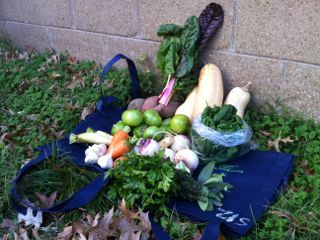How far away is your nearest supermarket? If you had no access to transportation could you walk to a store with healthy food options like fresh fruits and vegetables? For many living in North St. Louis City and County, few supermarkets combined with economic hardships has created what the United States Departments of Agriculture (USDA), Treasury, and Health and Human Services (HHS) call Food Desert census tracts. These are areas where poor access to supermarkets and affordable fresh produce causes residents to rely on less healthy food options, like processed foods found at convenient stores, gas stations, and fast food restaurants, which research says can possibly lead to various health issues. 
This problem calls for innovative solutions on the part of city, federal, and local communities. Community Supported Agriculture (CSA) may be one of those solutions.
In 2008, the US Congress charged USDA’s Economic Research Service (ERS) with conducting a one-year study on the causes and effects of food deserts on local communities and to recommend possible solutions to the problem. The report indicated a relationship between limited access to food in a community and less nutritious eating habits.
A 2012 follow up report by the ERS showed that food desert census tracks tend to be areas with higher levels of poverty, both urban and rural, and higher levels of nutrition-related problems, such as diabetes and obesity.
Elijah Wolfson, managing editor for Healthline.com, compiled data from the Centers for Disease Control (CDC) and the U.S. Census Bureau that showed cases of Type 2 Diabetes are more prevalent in areas considered food deserts. According to this report, the average rate of Type 2 Diabetes for the state of Missouri is 8.4%. St. Louis County, not considered a food desert, has a rate of 7.9%, while parts of St. Louis City, which are considered food deserts, have a higher rate of 10.8%.
Even more disturbing is a recent study by the CDC and National Institutes of Health (NIH) showing a significant increase in Type 1 and Type 2 diabetes in American youth under the age of 20. Between 2001 and 2009, cases of Type 2 diabetes rose 21% and Type 1 rose 23%.
Elizabeth Mayer-Davis, PhD and Past-President of the American Diabetes Association (ADA) states, “this research reinforces the need to ensure that young people with diabetes are getting more exercise, making healthier food choices and maintaining healthier weights.” This recommendation poses a challenge for families living in food deserts without access to healthy food options.
The Seeds of Hope Farm located in Spanish Lake, MO—identified as a food desert by the USDA—is one organization that has taken advantage of funding to help battle the negative health effects of food deserts in the community. The farm is located on a once empty lot behind St. Peters Lutheran Church on Trampe Ave, and is described as a Tiered Community Supported Agriculture (CSA) whose mission is to create “a healthy food culture for all members of our community, especially low-income families who are often priced out of healthy fresh ingredients and forced to stretch their food dollar by buying processed foods.”
Seeds of Hope CSA sponsor members receive fresh produce weekly by purchasing shares at $28 per week. This helps support lower income families who receive a subsidized share for $12 per week. Shareholders can also work on the farm and reduce their weekly cost.
Gabriel Hahn, Farm Manager at Seeds of Hope, says that one of the biggest challenges in starting the CSA is money, especially for access to water and equipment that is not already there. Grants are available to nonprofit organizations through the USDA and other organizations; however, more funding would be needed to expand this type of program to other areas in St. Louis.
| Related stories: Expanding Population Eating Away at Farmland; Childhood Obesity; Infographic: How Fat is your Food? |
Perhaps the city and federal government could help in the creation of Tiered CSA in areas considered food deserts. The city could contribute to the CSA sponsor membership to help support families in greatest need of healthy food assistance. It could also donate land—empty lots that could become community gardens supported by the CSAs. The Federal government could also expand its Supplemental Nutrition Assistance Program (SNAP), what used to be known as food stamps, to allow eligible participants to purchase food from CSAs—an option already being explored by Seeds of Hope Farm. Providing communities identified as food deserts with access to healthier, affordable foods could help combat the rise of nutrition related problems like diabetes and obesity. Nicolle von der Heyde

This work is licensed under a Creative Commons Attribution-NonCommercial-NoDerivs 3.0 Unported License














This was very interesting. I like the way you showed me all of this. Its interesting to know that some people have less and how we and the government helps to offer more.
This is not a good artical.:wuwu
I liked the story. But I didn’t still get if farming can help/save our community.
in my opinion, i think that if every one plants veggies and fruits in the community, people would be healthier and wouldnt have to worry about going out spending their money at local supermarkets.
My papaw grows corn and so my whole family never has to go out and buy it because we get it from him! it saves us money and tastes better!